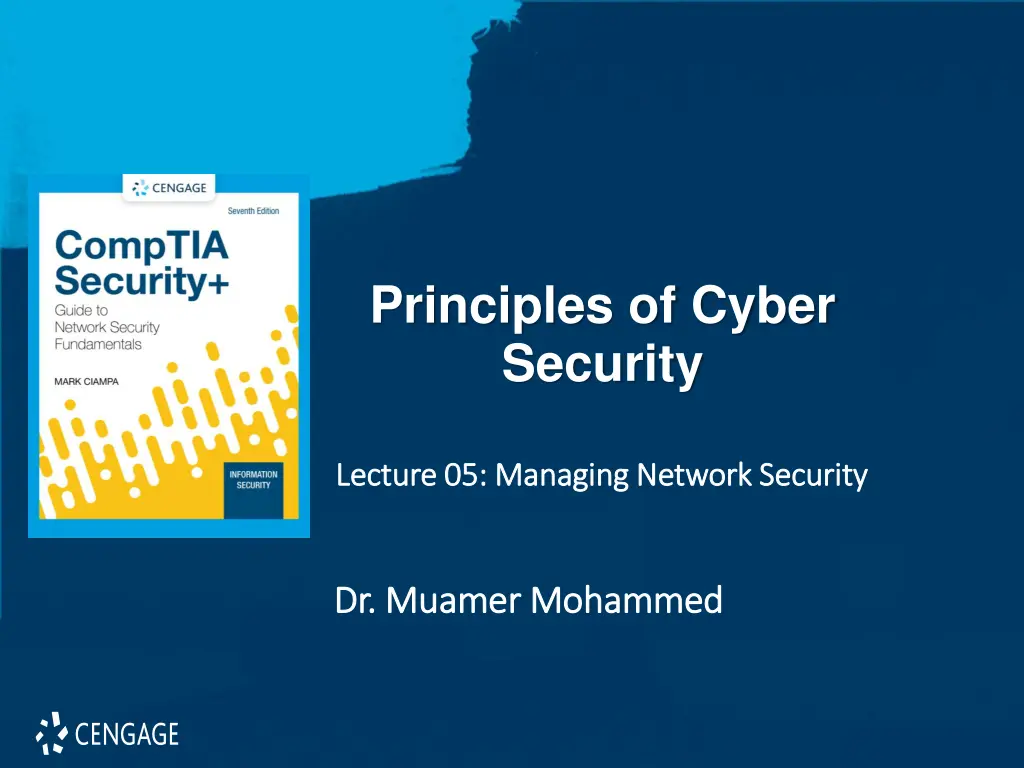
Managing Network Security: Types of Firewalls and Intrusion Detection Systems
Learn about the various types of firewalls and intrusion detection systems in managing network security. Explore packet filtering firewalls, next-generation firewalls, and more for effective cyber defense strategies.
Download Presentation

Please find below an Image/Link to download the presentation.
The content on the website is provided AS IS for your information and personal use only. It may not be sold, licensed, or shared on other websites without obtaining consent from the author. If you encounter any issues during the download, it is possible that the publisher has removed the file from their server.
You are allowed to download the files provided on this website for personal or commercial use, subject to the condition that they are used lawfully. All files are the property of their respective owners.
The content on the website is provided AS IS for your information and personal use only. It may not be sold, licensed, or shared on other websites without obtaining consent from the author.
E N D
Presentation Transcript
Principles of Cyber Security Lecture 05: Managing Network Security Lecture 05: Managing Network Security Dr. Dr. Muamer Muamer Mohammed Mohammed 1
Objectives 5.1 List and discuss the various types of firewalls and the common approaches to firewall implementation. 5.2 Define and describe the types of intrusion detection and prevention systems and the strategies on which they are based
Firewalls In InfoSec, a firewall is any device that prevents a specific type of information from moving between the outside world, known as the untrusted network (e.g., the Internet), and the inside world, known as the trusted network 3
Categories of Firewalls The most common types of firewalls are: Packet filtering firewalls Application layer proxy firewalls Stateful packet inspection firewalls Unified Threat Management (UTM) devices 4
Packet Filtering Firewalls Packet filtering firewalls are simple networking devices that filter packets by examining every incoming and outgoing packet header They can selectively filter packets based on values in the packet header, accepting or rejecting packets as needed These devices can be configured to filter based on IP address, type of packet, port request, and/or other elements present in the packet 5
Packet Filtering Firewalls Figure 5-1: Packet Filtering Firewalls 6
Next-Generation (NextGen) Firewalls Similar to UTM devices, next-generation firewalls (NextGen or NGFW) combine traditional firewall functions with other network security functions such as deep packet inspection, IDPSs, and the ability to decrypt encrypted traffic The functions are so similar to those of UTM devices that the difference may lie only in the vendor s description 7
Selecting the Right Firewall When evaluating a firewall, ask the following questions: 1. What type of firewall technology offers the right balance between protection and cost for the needs of the organization? 2. What features are included in the base price? What features are available at extra cost? Are all cost factors known? 3. How easy is it to set up and configure the firewall? How accessible are the staff technicians who can competently configure the firewall? 4. Can the candidate firewall adapt to the growing network in the target organization? 8
Intrusion Detection and Prevention Systems Intrusion Detection and Prevention Systems
Intrusion Detection and Prevention Systems IDPSs work like burglar alarms and combine tried-and- true detection methods from intrusion detection systems (IDSs) with the capability to react to changes in the environment, which is available in intrusion prevention technology 10
Intrusion Detection and Prevention Systems (Continued) Systems that include IPS technology attempt to prevent the attack from succeeding by: Stopping the attack by terminating the network connection or the attacker s user session 11
Intrusion Detection and Prevention Systems (Continued) Figure 5-2: Intrusion Detection and Prevention Systems 12
Host-Based IDPS A host-based IDPS works by configuring and classifying various categories of systems and data files Unless the IDPS is very precisely configured, benign actions can generate a large volume of false alarms Host-based IDPSs can monitor multiple computers simultaneously by storing a client file on each monitored host and then making that host report back to the master console, which is usually located on the system administrator s computer 13
Network-Based IDPS Network-based IDPSs monitor network traffic and, when a predefined condition occurs, notify the appropriate administrator The network-based IDPS looks for patterns of network traffic and must match known and unknown attack strategies against their knowledge base to determine whether an attack has occurred 14
Summary A firewall in an InfoSec program is any device that prevents a specific type of information from moving between the outside world (the untrusted network) and the inside world (the trusted network) Types of firewalls include packet filtering firewalls, application layer proxy firewalls, stateful packet inspection firewalls, and Unified Threat Management devices. There are three common architectural implementations of firewalls: single bastion hosts, screened-host firewalls, and screened-subnet firewalls. A host-based IDPS resides on a particular computer or server and monitors activity on that system. A network-based IDPS monitors network traffic; when a predefined condition occurs, it responds and notifies the appropriate administrator 15
Thank you 16






















